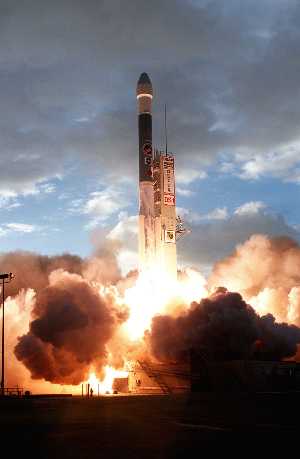By Patrick L. Barry
The sky will be filled with flying eggs on May 10, 2003, when a thousand students converge on The Plains, Virginia, for the first-ever national high school rocketry competition.
Called the Team America Rocketry Challenge (http://www.rocketcontest.org), the competition sets the goal of flying a custom-built, two-stage rocket carrying two raw eggs to a height of exactly 1,500 feet, and then returning the eggs to the ground unbroken. The team that comes closest to 1,500 feet without breaking their eggs will win the national title.
The competition is being organized by the Aerospace Industries Association and the National Association of Rocketry (NAR). NASA administrator Sean O'Keefe will attend the final event.
"The idea is to get kids interested in the world of aerospace," says Trip Barber, director of the competition and vice-president of the NAR. "And they will learn some important lessons about the power of math and science-and cooperation and teamwork-along the way."
To develop their designs, the students first used computer simulator software provided by NAR. Then they had to apply old-fashioned ingenuity and craftsmanship to bring the design to life and flight testing to refine it.
Students constructed rocket bodies using a combination of hobby-store rocket kit parts and custom materials. A typical rocket might consist of cardboard tubes from paper-towel or wrapping-paper rolls, a pre-made nose cone, rocket-kit body segments cut to size, and light-weight, balsa wood fins. But the greatest challenge for many was designing the compartment for the eggs.
Some used plastic Easter eggs as casings, padding the inside with bubble wrap, foam peanuts, or even gelatin. Others decided not to "reinvent the wheel," making a cradle from the egg-crate material used for shipping eggs. Some chose to make larger, more powerful rockets big enough to carry the eggs inside, while others made smaller, more efficient rockets that have a bulging egg compartment mounted on top.
A hundred unique designs will be put to the test in Virginia. Only one will win. But for the students, the real prize has already been won: Learning an approach to problem-solving that works, whether you're launching eggs over a field or sending astronauts to Mars.
In the end, it's all about the future: Future technologies and the kids who will grow up to create them. Many advanced technologies are being developed now by NASA's New Millenium Program (http://nmp.nasa.gov). Who will do that work in the future? Perhaps some kids who spent their weekends launching eggs in the air.
Are you a kid? Would you like to build your own rocket? Visit NASA's Space Place and learn how to make a bubble-powered rocket! (http://spaceplace.jpl.nasa.gov/rocket.htm.) It won't take you to Mars, but it's a good way to get started.
This article was provided by the Jet Propulsion Laboratory, California Institute of Technology, under a contract with the National Aeronautics and Space Administration.


